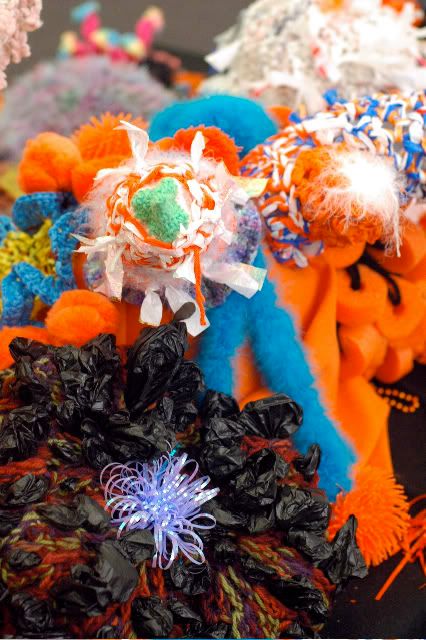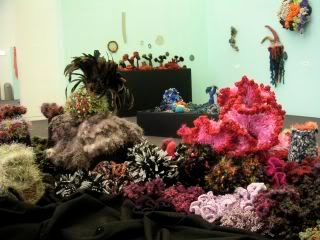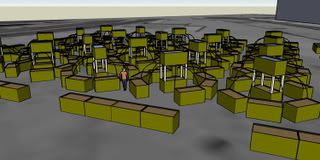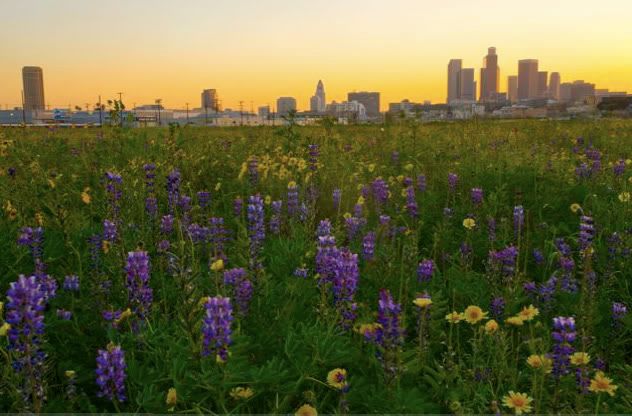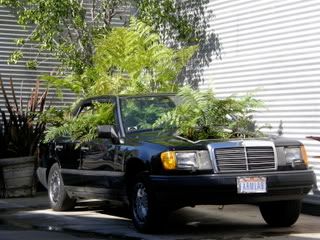 Junker Car #4
Junker Car #4
Farmlab (2008)
Steel, rubber, plantsAbout Farmlab's Junker Gardens SeriesFarmlab's latest
Junker Garden, a transformed 1990 Mercedes Benz 300s, planted with Australian tree ferns and irrigated by a misting system, joins a long list of once-were and still-are vehicles that combine automating with agriculture to produce relevant contemporary sculpture.
From the mobile nursery entrepreneur who parks his plant-brimming pickup every weekend at the corner of Sunset Boulevard and Echo Park Avenue, to a long list of artists and custom car builders, these sort of projects seem to go together like horsepower and hibiscus; power steering and petunias.
What helps distinguish Farmlab's series from other such efforts, though, are the conceptual underpinnings that preceded the tricking out of the various Farmlab rides, including the 'Benz cum Garden featured at
Santa Monica Museum of Art beginning January 25, 2008.Farmlab's Junker Gardens grow from the engine cavities, cabs, flatbeds, and trunks of scrap vehicles. Conjuring new ways to integrate organic life into an auto-centric built environment the wheeled vehicles are still mobile when pushed or towed.
The Gardens are a result of Farmlab’s ongoing project to generate viable urban agricultural models that are not dependent on land ownership, an effort inspired by the 2006 eviction of the nearby South Central Farmers.
The first junker car garden built by Farmlab (for the February, 2007 Garden of Brokenness exhibition) was a Chevrolet El Camino. Cucumbers, tomatoes, purple basil, marjoram and parsley were cultivated in the flatbed, while the hood was turned into a goldfish-filled fish tank.
Gearheads – including those with a pop culture or philosophical bent – took a keen interest in the piece. Jalopnik, for example, called the work. "a bizarre yet wonderful art project," and declared the vehicle an "object uniquely suited to a psychogeographic statement."
With this first Junker Garden proving so popular, Farmlab decided to create a second, breakout exhibition. In June, 2007, a donated Volvo 240 GL 1976 station wagon was dis-and-reassembled for the follow-up show and community demonstration, "How To Make A Junker Garden: From El Camino to Earthly Paradise."
The Volvo – created with the assistance of a pair of summer interns from Homeboy Industries – was later displayed during the nationwide 2007 Park(ing) Day happening, and was recently donated the Anne Street Elementary School.
A late 90’s Honda Accord was then donated to Farmlab. That Junker Garden now resides alongside the El Camino, in front of Farmlab's headquarters, underneath a neon sign that reads, "Another City is Possible."
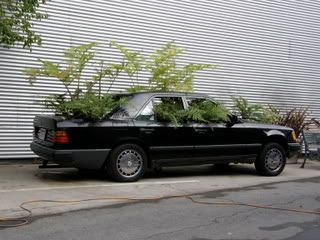 More About Farmlab & The Junker Gardens' Roots
More About Farmlab & The Junker Gardens' RootsFarmlab (2006-) was a studio inquiry into the means to support living things in the city of Los Angeles. Farmlab was born in part out of a pair of now-gone, large-scale urban Los Angeles ecologies: Not A Cornfield, and the South Central Farm.
During the SCF crisis, Farmlab project artist Lauren Bon asked the members of the multidisciplinary team of artists, writers, designers, agriculturalists, planners and laborers that she'd assembled, "What made the South Central Farm, the South Central Farm?"
Was it the particular location? The community of farmers? Their struggle? The tenuousness and fragility of the landowner-squatter dynamic? Or, perhaps, it was the soil, so tenderly cultivated, against many odds, for so many years, then so fertile and productive, and then, its roots shredded, its toilers' disbanded, its location abandoned?
Those discussions led to subsequent actions, and form a direct link to the Junker Garden here at SMMOA.
Back at Farmlab, then, as word spread that Bon and company were trying to help find an equitable and smart SCF solution, Angelinos and others began to propose to the team new possible sites for an urban farm. In each case, though, land ownership would not be in the hands of those who worked the earth.
Internally, Bon and her team referred to their SCF efforts as "Farmline." The name stemmed from discussions with a rail agency to borrow underused tracks and adjacent land to host agriculture plots. The water carriages and other farm equipment would travel along the tracks.
Soon, "Farmline" morphed into the more encompassing, "Farmlab" – with an emphasis on workshop, studio, and laboratory-style explorations. Tinkering began in earnest to trick out "ag bins" – deep, boxy wooden seed bins left over from Not A Cornfield – turning these bins into large planters featuring complex irrigation systems as well as wheels and a trailer hitch. In short, surrogate automobiles.
For price, aesthetic and reuse reasons, parallel efforts began to create mobile gardens from old cars, as well as from the ag bins.
Throughout 2007, ag bins were a primary tool in Farmlab's materials palette. Examples of Bon and co.'s continuing investigations of the concept of the "exploded" garden were evident in Farmlab projects such as, Agbins on Skid Row, and Agbin Ramblas, as well as in yet-to-be-realized works such as PS 1-100.
Agbins on Skid Row brought a communal garden to Los Angeles' central homeless community. Farmlab produced a fleet of 25 bins seeded with vegetables and flowers. Seven Skid Row agencies and their clients continue to foster and cared for the bins.
Under Spring is the name of a Farmlab-adjacent public space. Under Spring is home to a work-in-progress titled, Agbin Ramblas. This template for a citywide guerilla artwork uses the dimensions of the city sidewalk as a blueprint for creating parallel rows of planters complete with good soil and drip line irrigation. Farmlab's 36 bins (and counting) brimmed with pumpkin, chilies, squash, bananas, corn, avocados, guava, mint, beans, berries, tomatoes, marigolds, and sugar cane.
Implemented citywide, Agbin Ramblas would form a new kind of L.A. pedestrian walkway, in which the walker is surrounded with gardens. Home and business owners and tenants will need to approve planters prior to the bins' placement. Plants and soil will be salvaged from building sites, landfills and other places they are discarded.
Taking the "exploded garden" concept a step farther, Farmlab has begun planning and advocacy work on a project titled, PS 1-100. Standing for 100 "public spaces" or "permaculture square," and inspired by the work of USC's Manuel Castells, the project calls for the decentralized cultivation of a multi-nodal, mutable, networked garden along the contested Figueroa Corridor.
The creation of PS 1-100 spaces would not need to occur on the grand scale of Not A Cornfield. New zones could include a crack in the sidewalk; an unpaved and disused stretch of tarmac.
Or, perhaps most obviously apropos to the post-Detroit automotive and public space-poor capital of the United States: The engine cavity and trunk void of a junker car.
LINKS:http://farmlab.org/2007/05/how-to-make-junker-garden-demonstration.html
http://farmlab.org/2007/02/garden-of-brokenness-exhibition-opens.html
http://farmlab.org/2007/03/team-members-farmlab-under-spring.html
http://jalopnik.com/336716/the-el-camino-chia-pet-a-situationist-critque-of-the-chiamino
http://www.kcet.org/explore-ca/web-stories/sustaining/farmlab.php
http://www.bigshowindustries.com/art/farmlab/mk1.html
http://www.bigshowindustries.com/art/farmlab/mk2.html
PHOTOS:Farmlab photos by Kate BalugLabels: Lauren Bon, metabolic sculpture


